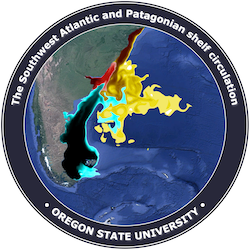
The Southwest Atlantic circulation
Here is a list of published papers related to the Southwest Atlantic and Patagonian shelf circulation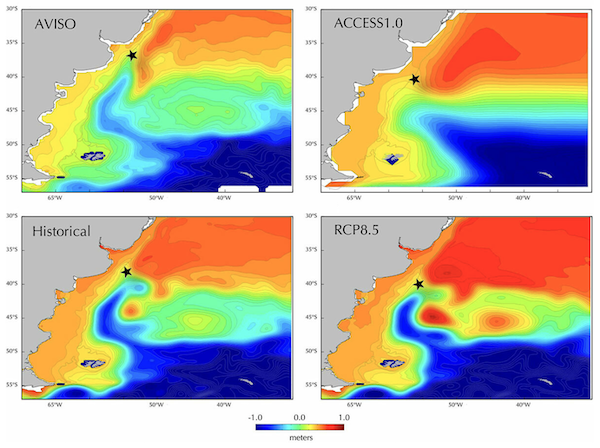
Abstract: This chapter evaluates the impacts of climate change on the Southwestern Atlantic Shelf (SWAS) circulation, a region extending from Cabo Frio, Brazil (~28°S) to the tip of Tierra del Fuego, Argentina (~55°S). Satellite observations reveal a widespread warming trend across the SWAS, peaking at 0.31°C per decade in the South Brazil Bight, accompanied by a sea level rise of approximately 3 mm per decade. Analysis of CMIP5 simulations indicates an intensification of the Brazil Current transport and a weakening of the Malvinas Current transport, resulting in distinct warming and freshening patterns in the upper ocean. Complementary downscaling experiments further suggest that the northern and central SWAS will experience the most significant impacts due to increased on-shelf flow of Brazil Current waters. In contrast, climate change impacts on the southern region are projected to be substantially smaller, with downscaling experiments showing a reduced inflow of subantarctic waters through the Drake Passage. Consequently, this study concludes that changes driven by projected emissions are likely to exacerbate warming and salinification in the northern and central shelf areas, with broad implications for local marine ecosystems and human activities.
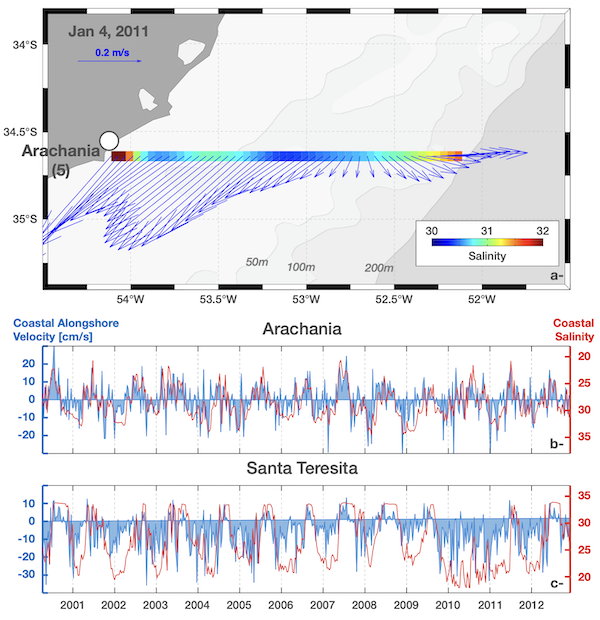
Abstract: The wedge clam, Donax hanleyanus, inhabits sandy beaches in the subtropical and temperate regions of the Atlantic coast of South America. Its distribution spans over 20 degrees of latitude from Brazil to Argentina, with the southernmost part of its range being influenced by the Rio de la Plata (RdlP) estuary, which limits the southward larval expansion. We used an individual-based model (IBM) to assess the larval connectivity patterns of the wedge clam during the period 2000-2012. The IBM combines a 3D hydrodynamic model with a biological sub-model that considers larval mortality due to low salinity (< 7, and > 9) and sea surface temperature range (high > 30°C or low < 9°C). The main larval connectivity patterns were observed near the release/recruitment areas, suggesting a high potential for self-recruitment. Based on the IBM and adult abundance data, we also identified the likely source and sink areas within this metapopulation. Source beach areas were Navegantes and Cassino in Brazil (from 26.3° S to 34.34°S), Arachania in Uruguay (34.56°S), and Santa Teresita in Argentina (37.15°S). A low probability of larval transport towards the poleward limit of the species' distribution was observed, supporting an irregular recruitment pattern typical of sink populations located at the edge of the distribution range of metapopulations. Larval mortality due to warm or cold waters did not affect connectivity patterns for this subtropical species. Southward larval transport across the RdlP estuary (from Uruguayan to Argentine beaches) only occurred for larvae released on early January 2011, concurrently with the strongest La Niña year observed during the study period. In light of a changing climate, marked by potential increases in extreme La Niña events and a poleward shift of atmospheric circulation patterns over the South Atlantic, we anticipate a strengthening of larval transport across the RdlP and a subsequent poleward expansion of the species’ distribution range.
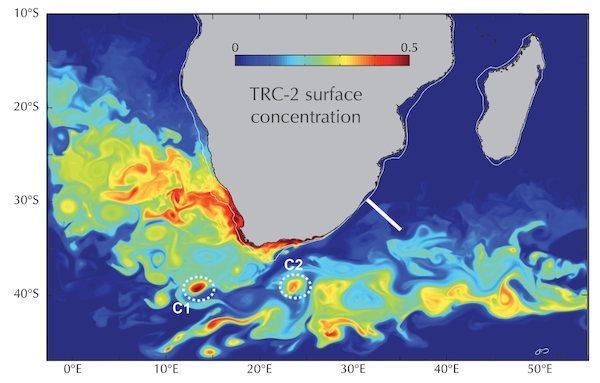
Abstract: This modeling study analyzes the circulation over the AgulhasBank (AB). It is suggested that the time mean circulation over the bank is primarily driven by the inflow of shelf waters from the northeastern region, and not by local forcing as previously postulated. Seasonal variations of the circulation and temperature and salinity fields are highly correlated with the atmospheric forcing. Currents shift inshore during the winter, returning to its original position during summer. The equatorward flow in the western AB, which includes a deep, previously unreported, countercurrent, strengthens during spring and summer and wanes during fall and winter. Tracer diagnostics and Eulerian mass balances reveal very energetics mass exchanges between the eastern AB and the Agulhas Current (AC). The AB Bight is the preferential site for these exchanges. Lagrangian diagnostic show 0.45 Sv of deep open‐ocean waters entrained into the bottom layer of the shelf. Cross‐shelf exchanges produce significant water mass transformations. Tides play an unexpectedly significant role on the AB circulation. Preliminary considerations suggest that shelf/open‐ocean interactions could have a significant impact on water mass conversions within the AC.
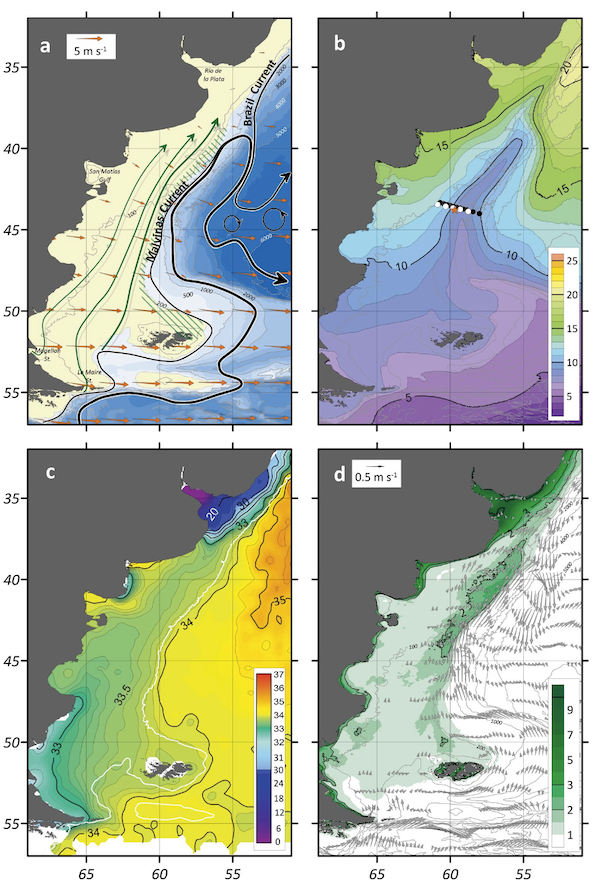
Abstract: The Patagonia shelf-break front presents sharp offshore changes in surface temperature, salinity, chlorophyll, and horizontal velocity shear. In summer, the cross-shore temperature and salinity changes are not uniform, suggesting the existence of multiple fronts. In winter, the offshore changes are fairly uniform, displaying a single thermohaline front located just offshore from the shelf-break. Cross-front temperature and salinity present significant seasonal variations associated with intense vertical stratification over the shelf during summer. The thermocline provides a density interval for cross-front isopycnal exchange, which may fertilize the outer shelf waters. The salinity front extends from the surface to the bottom and is observed year-round. Frontal displacements occur throughout the water column. The high surface chlorophyll along the front suggests a sustained nutrient flux to the shelf-break upper layer. Numerical experiments indicate intense frontal upwelling mediated by the interaction of the Malvinas Current with the bottom topography and suggest that upwelling in upstream portions of the shelf-break, advected northward along the shelf edge, may further modulate the nutrient fluxes required to sustain frontal productivity. A southward displacement of the northernmost extension of the front observed during the past decades may have biological and biogeochemical impacts.
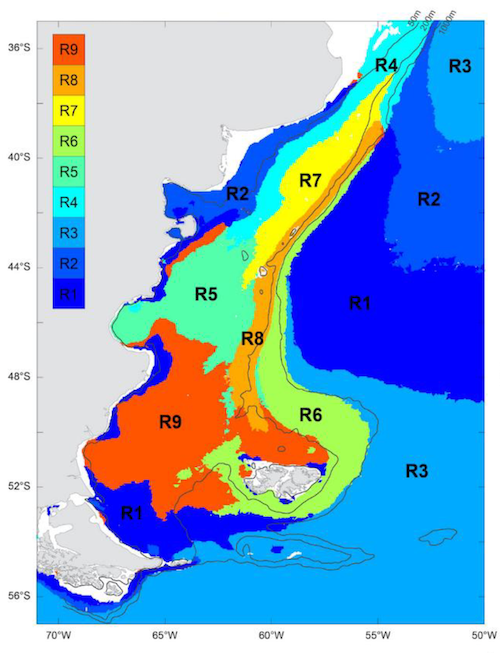
Abstract:The Southwestern Atlantic Ocean (SWA), is considered one of the most productive areas of the world, with a high abundance of ecologically and economically important fish species. Yet, the biological responses of this complex region to climate variability are still uncertain. Here, using 24 years of satellite-derived Chl-a data, we classified the SWA into 9 spatially coherent regions based on the temporal variability of Chl-a concentration, as revealed by SOM (Self-Organizing Maps) analysis. These biogeographical regions were the basis of a regional trend analysis in phytoplankton biomass, phenological indices, and environmental forcing variations. A general positive trend in phytoplankton concentration was observed, especially in the highly productive areas of the northern shelf-break, where phytoplankton biomass has increased at a rate of up to 0.42 ± 0.04 mg m−3 per decade. Significant positive trends in sea surface temperature were observed in 4 of the 9 regions (0.08–0.26 °C decade−1) and shoaling of the mixing layer depth in 5 of the 9 regions (−1.50 to −3.36 m decade−1). In addition to the generally positive trend in Chl-a, the most conspicuous change in the phytoplankton temporal patterns in the SWA is a delay in the autumn bloom (between 15 ± 3 and 24 ± 6 days decade−1, depending on the region). The observed variations in phytoplankton phenology could be attributed to climate-induced ocean warming and extended stratification period. Our results provided further evidence of the impact of climate change on these highly productive waters.
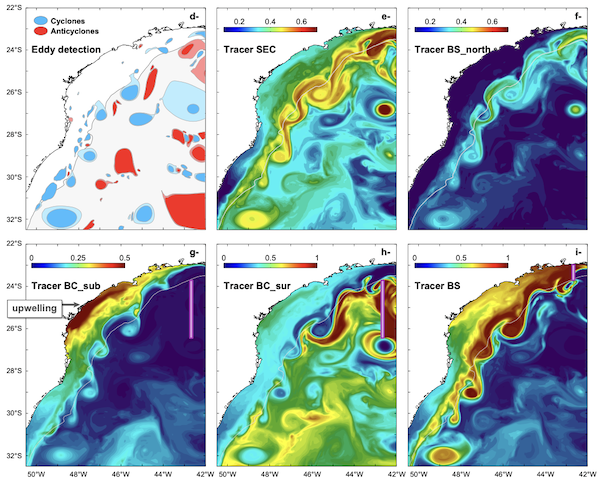
Abstract:The strong interaction between the Brazil Current and the adjacent shelf is clearly visible in satellite-derived products (sea surface temperature, salinity, and chlorophyll-a concentration). Assessments of circulation features and cross-shelf exchanges from these products are, however, limited to the surface layer. Here we analyze the regional circulation and dynamics using the results of a suite of process-oriented, high-resolution numerical experiments. Passive tracers and Lagrangian floats characterize the exchanges between the shelf and the open ocean, identifying regions of high variability, and assessing the contribution of small-scale eddies to the cross-shelf mass exchanges. We estimate that 0.2-0.4Sv of the shelf transport variability between 34°S and 25°S comes from ocean internal variability which represents ~50%-70% of the total variability. Between 25°S and 21°S, internal ocean variability represents more than 90% of the shelf transport variability. We find that generation of cyclonic eddies is more frequent (>15% of the time) at the shelfbreak bights. The core of these eddies contains fresher, colder, and more nutrient-rich shelf waters. Maps of satellite chlorophyll-a concentration suggest that the horizontal and vertical exchanges of mass associated with these eddies are a critical element of the primary production cycle.
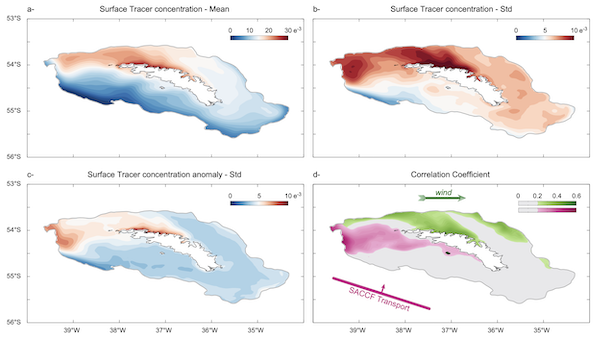
Abstract: A high-resolution ocean model is used to characterize the variability of the shelf circulation and cross-shelf transport around the South Georgia island (SG). The time-mean shelf circulation consists of a counterclockwise flow with a net onshelf mass flow in the south and a net offshelf mass flow in the north. In the south, the cross-shelf exchanges show a two-layer structure with an offshelf flow below 350m and onshelf flow above. In the north, the cross-shelf exchanges show a three-layer structure with the onshelf flow found only between 350m-50m. Correlation analysis shows that winds and the Southern Antarctic Circumpolar Current Front (SACCF) current modulate the variability of the shelf circulation and cross-shelf transport. Local wind stress is significantly correlated with the coastal currents, mid-shelf jet, and cross-shelf transports in the upper layer, while the SACCF modulates the shelf and cross-shelf transports in the southwestern shelf. Likewise, an Empirical Orthogonal Function analysis indicates that the first mode of shelf circulation variability is highly correlated with the SACCF, while the second mode is explained by the local wind stress and significantly correlated with the Antarctic Oscillation. The El Niño Southern Oscillation does not significantly contribute to the shelf circulation but is significantly correlated with the surface temperature variability. The atmospheric teleconnection drives changes in local heat flux, such that warm El Niño conditions over the equatorial Pacific are associated with a cooling of the SG waters. This superposes local signals onto temperature anomalies advected from upstream in the ACC found in previous studies.
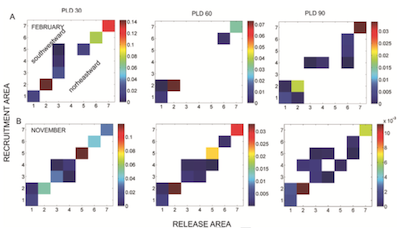
Abstract: The yellow clam Mesodesma mactroides is a cool-water species that typifies sandy beaches of the Southwestern Atlantic Ocean (SAO), which embraces one of the strongest ocean warming hotspots. The region is influenced by the Rio de la Plata (RdlP), which represents a zoogeographic barrier that restricts its larval exchange. We investigated yellow clam larval connectivity patterns using an individual based model (IBM). The IBM combined outputs from a 3D hydrodynamic model with a clam submodel that considered salinity- and temperature-dependent mortality for the planktonic larvae. Connectivity across the RdlP estuary occurred only for larvae released in spring during a strong La Niña event. Mortality due to freshwater precluded larval transport across the RdlP, whereas larval mortality induced by warmer waters reduced connectivity, leading to self-recruitment in most areas. Warming acceleration in this hotspot could further restrict larval connectivity between populations in the SAO, with conservation implications for this threatened species.
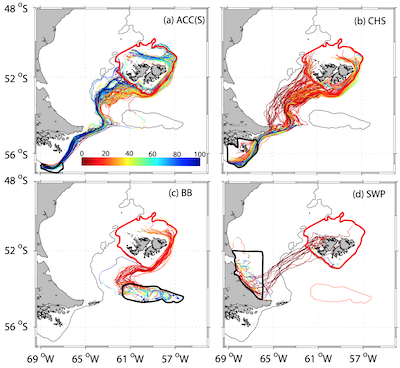
Abstract: The Malvinas Islands shelf (MIS) encompasses one of the most productive portions of the southwestern Atlantic. Large phytoplankton blooms, which constitute the base of the marine food web, emerge from the northern sector of the MIS and extend hundreds of kilometers northward along the Patagonian shelfbreak. The physical processes contributing to MIS fertilization are poorly understood. Here we use the results of a high-resolution ocean model to characterize circulation and water mass exchanges between the MIS and the Southern Ocean, as well as to identify the physical processes underlying fertilization of the shelf waters. Model results show that the shelf is characterized by an anticyclonic circulation pattern in the southwestern region that intensifies during summer and weakens during winter. The blocking effect of the islands leads to development of an upwind westward-flowing current in the northern portion of the MIS, recirculation cells in the western portion, and a northward throughflow in the narrow strait separating them. Particle tracking experiments reveal that the northern portion of the Drake Passage is the largest water mass source for the MIS. Passive tracers indicate that the place where the Antarctic Circumpolar Current collides with the MIS is the main shelfbreak obduction region. Subsequent development of tracer obduction is largely driven by the synergetic interaction of tides and wind forcing. After spreading along the southwestern shelfbreak, the concentration of tracer peaks in the winter and decays during the spring. In summer, the tracer accumulates on the lee of the islands in agreement with satellite images of chlorophyll-a concentration. Additional experiments show that there is an important contribution of MIS waters to the Patagonian shelfbreak front.
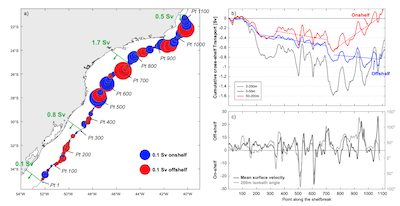
Abstract: A high-resolution ocean model is used to characterize the circulation and cross-shelf exchanges in the Brazilian/Uruguayan portion of the southwestern Atlantic shelf. Cross-shelf exchanges are strongly modulated by the bottom topography. There is ∼1.2 Sv of on-shelf transport between 21°S and 25.2°S, and ∼1.6 Sv of off-shelf transport between 35°S and 25.2°S. North of 25.2°S, the cross-shelf exchanges show a two-layer structure with an off-shelf flow in the upper 50m and on-shelf flow deep below. A Lagrangian diagnostic shows that ∼0.15 Sv of deep waters from the Brazil Current (z > 200 m) are injected into the shelf. Mixing with ambient waters produces a spicier (warmer and saltier) water mass, which is ejected into the open ocean in the southern region. Backward in-time particle's trajectories analysis reveals that 95% of the southward shelf transport at 32°S originates in the open ocean at 22°S. Our model diagnostics show that there is a very limited connectivity between the shelf regions north and south of Cabo Frio. Correlation analysis shows no significant influence of El Niño Southern Oscillation (ENSO) and Southern Annular Mode (SAM) on the time variability of the cross-shelf transport. Cross-shelf transports, however, are significantly correlated with the local wind stress variability.
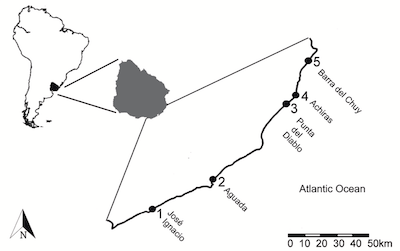
Abstract: The biophysical mechanisms influencing larval distribution and their impacts on the metapopulation dynamics of sandy beaches, particularly the connectivity patterns associated with larval dispersal, are poorly understood. Here, we identify larval connectivity patterns of the mole crab Emerita brasiliensis in the coast of Uruguay. A biophysical individual based model (IBM) of larval transport was coupled to a regional high-resolution physical model to estimate the monthly and interannual variation of larval connectivity, as well as the impact of the length of the reproductive period on it. Larval connectivity showed marked interannual variations, which were mainly related to interannual changes in seasonal winds and associated ocean circulation patterns, particularly during La Niña years. The southernmost area where E. brasiliensis occurs only received larvae from the nearest release area in November and January spawning events during a strong La Niña year, characterized by intense northeasterly winds. The Uruguayan coast constitutes the leading (poleward) edge of the distribution of E. brasiliensis, where climate change effects are projected to intensify. Extrapolation of these results to a climate change scenario with stronger La Niña events, suggest that larval transport to southernmost beaches will become more probable.
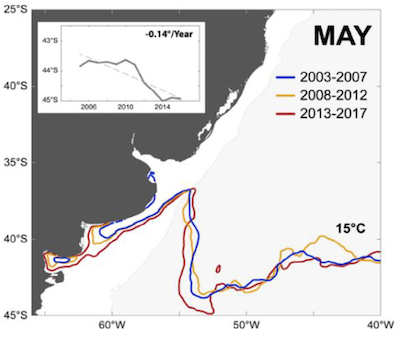
Abstract: In the southwest South Atlantic Ocean (SWAO) strong ocean surface warming hotspots have been observed mainly along the path of the Brazil Current (BC), Brazil-Malvinas Confluence (BMC), and in the Río de la Plata (RdlP). However, there is no knowledge about the signature of ocean hotspots below the surface and the potential effects of ocean warming on marine biota. In this work, we provide initial evidence of how deep the hotspots of the SWAO extend in the water column, in particular at mid-water and bottom layers where two marine species - the green turtle (Chelonia mydas) and the Patagonian scallop (Zygochlamys patagonica) - inhabit. We compare 15 years (2003–2017) of Copernicus Marine Environment Monitoring Service (CMEMS) ARMOR3D high−resolution (1/4◦) 3-D temperatures reprocessed from combined satellite and in situ observations with high−resolution (1/12◦) Mercator ocean reanalysis. We also use location data of C. mydas and Z. patagonica to discuss the potential impacts of warming on these species in terms of geographic distribution, phenological shifts and thermal tolerance. The potential distribution of C. mydas changes in relation to the sea surface temperature (SST) and the bathymetry. The warming of the whole water column in the RdlP (>0.4◦C/decade) and the southward movement of the mean surface isotherms, which likely drove turtle displacements, could enable the opening up of novel optimal thermal habitats and/or a longer seasonal residency for the species. At the BMC, warming is driven by the southward displacement of the BC during the past decades. Ocean model temperature indicates cooling/warming in deep waters along the outer shelf and shelf break regions, which vary according the displacements of the BMC. The expected warming of the waters over the Patagonian scallop largest bed could exceed the thermal tolerance of this species and its survival. Given the lack of long-term monitoring programs to address the impacts of climate change on marine biota in the SWAO, our results provide the first effort to call the attention of stakeholders and decision makers on marine conservation and fishery management to work toward better management strategies in the context of climate change.
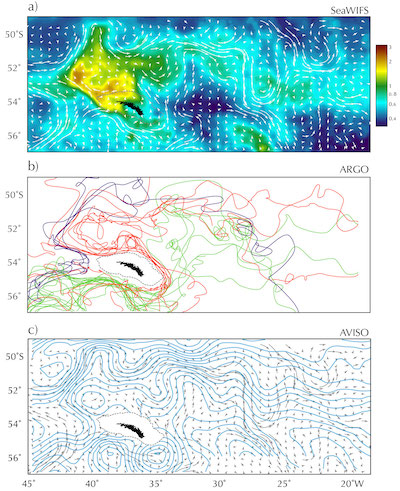
Abstract:The northeast corner of the Scotia Sea hosts one of the largest chlorophyll-a blooms of the Southern Ocean. This bloom peaks to the northwest of the island of South Georgia, extending eastward for hundreds of kilometers. Although the Southern Ocean has many islands of similar size, South Georgia is ecologically one of the most significant: it not only sustains one of the Southern Ocean’s largest and most diverse ecosystems but also is its single most important region for biological carbon sequestration. While the exceptional nature of South Georgia’s blooms has been widely recognized, both the physical processes that contribute to their fertilization and the reasons why these blooms are larger than those of other similar regions (e.g. Kerguelen or Crozet Islands), are poorly understood. We use the results of a high-resolution ocean model to investigate the physical processes that mediate the entrainment of deep, iron rich waters into the surface layers of the South Georgia region. We show that the Southern Antarctic Circumpolar Current Front, the southernmost jet of the Antarctic Circumpolar Current (ACC), pumps iron-enriched waters from the deep ocean onto the bottom layers of South Georgia’s shelf. These waters are upwelled along the northern coast of the island and are then exported into the Georgia Basin, where topographically steered circulation shields them from the dispersive effects of local currents and eddies, thus allowing the bloom development.
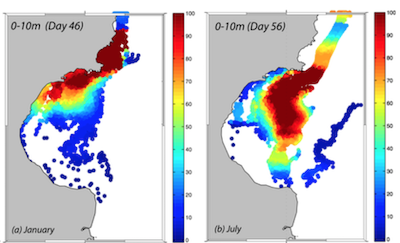
Abstract:This study identifies the dynamical mechanisms driving seasonal variations in oceanic circulation and water mass characteristics of the Gulf of San Jorge (GSJ) and its exchanges with the Patagonian Shelf (PS). A suite of process-oriented numerical experiments indicates that GSJ circulation is mainly driven by tidal forcing and modulated by wind forcing and intrusions from the PS. During late spring and summer, stratification decouples the upper and deeper layers of the gulf, leading to a shallow, wind-forced surface circulation and a deeper, density driven, cyclonic geostrophic flow. The subsurface circulation is induced by differential tidal mixing in coastal and deep areas and its intensity is strongly affected by the temporal variability of the atmospheric heat flux, which increases from spring to summer and fades from fall to winter. As stratification weakens, circulation patterns are replaced by wind-driven anticyclonic gyres in the south and an open cyclonic loop in the north. Passive tracer diagnostics show that in summer, surface and subsurface waters from the GSJ northern coast are exported and replaced by waters from the coastal portion of PS currents. The renewal of bottom waters is slower: A small portion upwells in the southwestern coast but most are ventilated by winter convection in the southern region and by intrusions of PS waters in the northern region
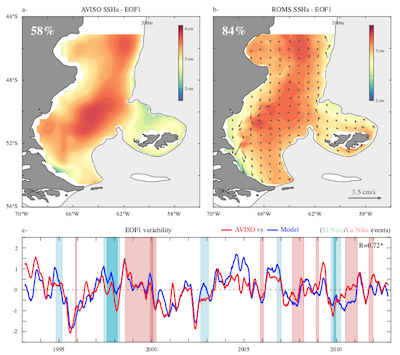
Abstract: In this study, we identify the drivers of the dominant mode of sea surface height interannual variability over the Patagonian shelf using a suite of process-oriented numerical experiments. Consistent with altimetry, the dominant mode of the model sea surface height interannual variability, which accounts for approximately 84% of the total variance, exhibits a robust deterministic low-frequency variability. The weak sea surface height gradients indicate that this mode has a weak dynamical effect, but the contribution of the steric effect is shown to be non significant. Here we demonstrate that the temporal variability of this mode is not driven by heat or freshwater fluxes but by the propagation of sea surface height perturbations generated in the Pacific. In particular, we show that sea surface height interannual variability over the Patagonian shelf is influenced by wind stress forcing in the offshore region of southern Chile and by the propagation of equatorial sea surface height anomalies.
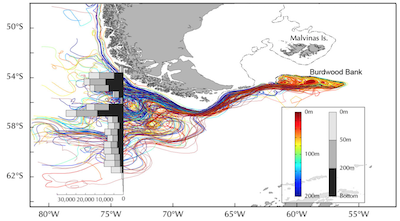
Abstract: A suite of high‐resolution numerical simulations characterizes the oceanic circulation in the Burdwood Bank (BB), a shallow seamount located in the northeastern end of the Drake Passage. Model analysis shows energetic upwelling and mixing uplifting deep and benthic waters into the photic layer. Tides and the Antarctic Circumpolar Current are the primary drivers of the bank's circulation. Tidal forcing is the main driver for the entrainment of deep waters into the upper layers of the bank and local wind forcing for the detrainment of these waters into the deep ocean. Passive tracer diagnostics suggest that the dynamical processes triggered by the BB could have a significant impact on local ecosystems and the biogeochemical balance of the southwestern Atlantic region, which is one of the most fertile portions of the Southern Ocean. Model results are robust—they are reproduced in a wide array of model configurations—but there is insufficient observational evidence to corroborate them. Satellite color imagery does not show substantial chlorophyll blooms in this region but it shows strong phytoplankton plumes emanating from the bank. There are several potential explanations for the chlorophyll deficit, including lack of light due to persistent cloud cover, deep mixing layers, fast ocean currents and the likelihood that blooms, while extant, might not develop on the surface. None of these possibilities can be confirmed at this stage.
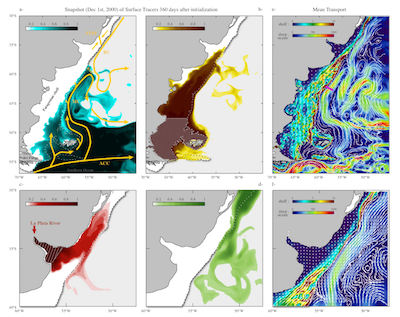
Abstract: A high-resolution ocean model is used to characterize the local and remote driving mechanisms of the variability of the Patagonian shelf circulation. Local forcing includes the effects of tides, buoyancy fluxes and wind, while remote forcing represents the impact of the adjacent deep-ocean currents. There is an abrupt change of the dynamical characteristics of the shelf circulation at 40°S. South of 40°S, the seasonal variations of the shelf circulation are out of phase with the local wind stress and are driven by deep ocean inflows originated in the Drake Passage. The inter-annual variability of the shelf circulation is principally driven by the wind and shows a significant correlation with the time variations of the Southern Annular Mode index. The variability of the circulation and upwelling at the shelfbreak region are modulated by the variability of the Malvinas Current transport at low frequency (periods higher than two years), and by the local wind stress at higher frequencies. North of 40°S, the local wind forcing drives the seasonal variations of the shelf transport. The inter-annual variability of the flow is driven by the combined action of the Rio de la Plata discharge (significantly correlated with the El Niño Southern Oscillation), local wind stress and the Brazil-Malvinas Confluence in the outer shelf. In agreement with previous studies, we show that while the position of the confluence marks the location of the largest offshelf transports, it does not determine their magnitude. The offshelf transport variability is controlled by the local wind at high frequency (periods less than a year) and by the equatorward inflow of southern waters at longer periods. Our simulation indicates that the variability of the Subtropical Shelf Front is modulated by the local wind stress forcing, position of the Brazil/Malvinas Confluence and the equatorward inflow of Subantarctic waters.
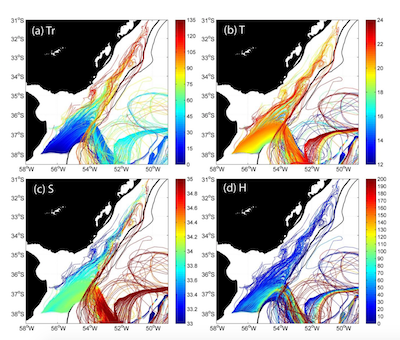
Abstract: It has been suggested that the Subtropical Shelf Front (STSF) could be a preferential site for the detrainment of Subantarctic Shelf Waters (SASW) and related planktonic shelf species onto the open SW Atlantic Ocean. The offshore detrainment of SASW and planktonic shelf species might be an exportation mechanism, affecting the population abundances of fishing resources in Argentina, Uruguay and Southern Brazil. In this study, we characterize for the first time the 3-D structure of the STSF and the main routes of offshore export of SASW from the Patagonian shelf during austral summer (summer and early fall) and winter (winter and early spring) by using numerical hydrodynamical model results and Lagrangian tracking simulations of neutrally buoyant floats. The transport of SASW towards the open ocean is 1 Sv (1 Sv = 106 m3.s-1) during summer and 0.8 Sv during winter. SASW are exported offshore mainly near the Brazil–Malvinas Confluence (BMC) region during both seasons. The STSF appears to act as an important retention mechanism for the plankton over the inner and middle shelf mainly during late summer and early fall. Our findings could explain the life cycle of distinct fish species which are distributed in the region, as well as the population abundance variability of such species.
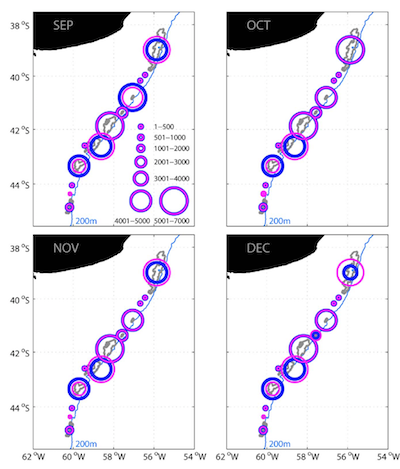
Abstract: The largest beds of the Patagonian scallop (Zygochlamys patagonica) have been associated with high chlorophyll- a concentration observed along the Patagonian Shelf Break Front but there is no supported hypothesis about how this benthic-pelagic connection is maintained. In this work we address the main physical processes driving the benthic-pelagic linkages through oriented numerical experiments derived from a realistic, high-resolution numerical model, and Lagrangian stochastic simulations. The results support the hypothesis of an important dynamical control of the slope current on the fate of surface released passive particles and their subsequent bottom settlement. A high percentage of the particles released at the surface settled over the scallop beds. The particles remaining at the surface layer followed a prevailing NE flow direction with low cross-shelf dispersion. Additional experiments show that the secondary cross-shelf circulation forced by the slope current promotes downwelling and hence the settlement of particles on the westward side (onshore) of the shelf break. The percent of particles settling over the scallop beds exceeded 80% by the addition of vertical stochastic turbulence and tidal forcing. These results highlight the importance of including the vertical diffusivity in particle tracking experiments to better estimate benthic-pelagic interaction processes.
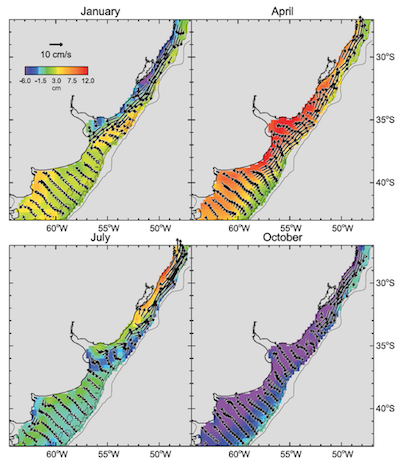
Abstract: Altimeter sea surface height (SSH) fields are analyzed to define and discuss the seasonal circulation over the wide continental shelf in the SW Atlantic Ocean (278–438S) during 2001–2012. Seasonal variability is low south of the Rio de la Plata (RdlP), where winds and currents remain equatorward for most of the year. Winds and currents in the central and northern parts of our domain are also equatorward during autumn and winter but reverse to become poleward during spring and summer. Transports of shelf water to the deep ocean are strongest during summer offshore and to the southeast of the RdlP. Details of the flow are discussed using mean monthly seasonal cycles of winds, heights, and currents, along with analyses of Empirical Orthogonal Functions. Principle Estimator Patterns bring out the patterns of wind forcing and ocean response. The largest part of the seasonal variability in SSH signals is due to changes in the wind forcing (described above) and changes in the strong boundary currents that flow along the eastern boundary of the shelf. The rest of the variability contains a smaller component due to heating and expansion of the water column, concentrated in the southern part of the region next to the coast. Our results compare well to previous studies using in situ data and to results from realistic numerical models of the regional circulation.
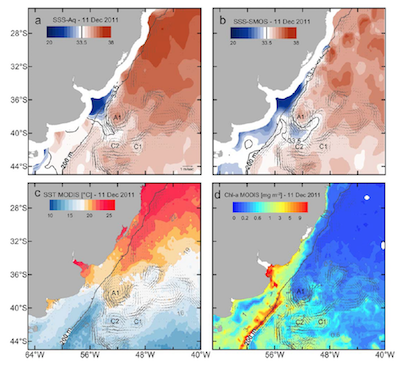
Abstract: Satellite-derived sea surface salinity (SSS) data from Aquarius and SMOS are used to study the shelf-open ocean exchanges in the western South Atlantic near 35 S. Away from the tropics, these exchanges cause the largest SSS variability throughout the South Atlantic. The data reveal a well-defined seasonal pattern of SSS during the analyzed period and of the location of the export of low-salinity shelf waters. In spring and summer, low-salinity waters over the shelf expand offshore and are transferred to the open ocean primarily southeast of the river mouth (from 36 S to 37 300S). In contrast, in fall and winter, low-salinity waters extend along a coastal plume and the export path to the open ocean distributes along the offshore edge of the plume. The strong seasonal SSS pattern is modulated by the seasonality of the along-shelf component of the wind stress over the shelf. However, the combined analysis of SSS, satellite-derived sea surface elevation and surface velocity data suggest that the precise location of the export of shelf waters depends on offshore circulation patterns, such as the location of the Brazil Malvinas Confluence and mesoscale eddies and meanders of the Brazil Current. The satellite data indicate that in summer, mixtures of low-salinity shelf waters are swiftly driven toward the ocean interior along the axis of the Brazil/Malvinas Confluence. In winter, episodic wind reversals force the low-salinity coastal plume offshore where they mix with tropical waters within the Brazil Current and create a warmer variety of low-salinity waters in the open ocean.
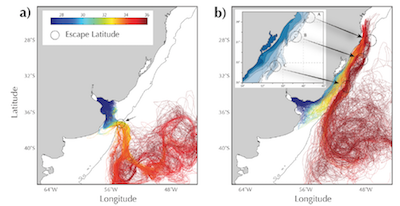
Abstract: A high-resolution model is used to characterize the dominant patterns of sea surface salinity (SSS) variability generated by the freshwater discharges of the Rio de la Plata (RdlP) and the Patos/Mirim Lagoon in the southwestern Atlantic region. We identify three dominant modes of SSS variability. The first two, which have been discussed in previous studies, represent the seasonal and the interannual variations of the freshwater plumes over the continental shelf. The third mode of SSS variability, which has not been discussed hitherto, represents the salinity exchanges between the shelf and the deep ocean. A diagnostic study using floats and passive tracers identifies the pathways taken by the freshwater plumes. During the austral winter (JJA), the plumes leave the shelf region north of the BMC. During the austral summer (DJF), the plumes are entrained more directly into the BMC. A sensitivity study indicates that the high-frequency component of the wind stress forcing controls the vertical structure of the plumes while the low-frequency component of the wind stress forcing and the interannual variations of the RdlP discharge controls the horizontal structure of the plumes. Dynamical analysis reveals that the cross-shelf flow has a dominant barotropic structure and, therefore, the SSS anomalies detected by Aquarius represent net mass exchanges between the shelf and the deep ocean. The net cross-shelf volume flux is 1.21 Sv. This outflow is largely compensated by an inflow from the Patagonian shelf
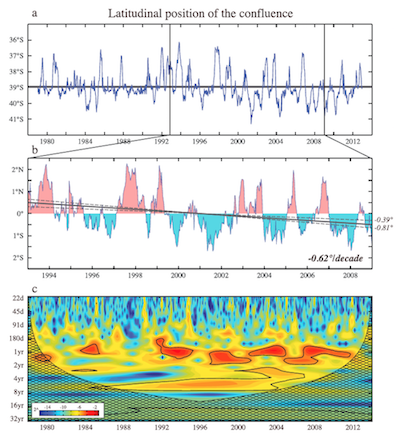
Abstract: Observations show abrupt changes in the oceanic circulation of the southwestern Atlantic. These studies report a southward drift of the Brazil/Malvinas Confluence (BMC) and a change in the spectral characteristics of the Malvinas Current (MC) transport. We address the cause of these changes using the result of a high-resolution numerical experiment. The experiment, which is consistent with observations, shows a southward BMC displacement at a rate of 0.62°/decade between 1993 and 2008, and a shift of the spectral characteristics of the MC transport after 1999. We find that these changes are driven by a weakening of the northern branch of the Antarctic Circumpolar Current, which translates to a weakening of the MC transport and a southward BMC drift. The drift changes the spectral characteristics of the MC transport, which becomes more influenced by annual and semiannual variations associated with the BMC.
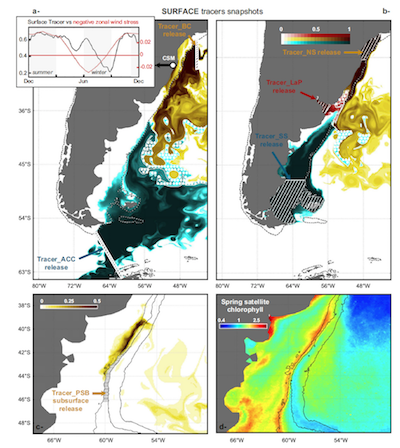
Abstract: This article presents the results of a high-resolution (1/12 ), two-way nested simulation of the oceanic circulation in the southwestern Atlantic region. A comparison between the model results and extant observations indicates that the nested model has skill in reproducing the best-known aspects of the regional circulation, e.g., the volume transport of the ACC, the latitudinal position of the BMC, the shelf break upwelling of Patagonia, and the Zapiola Anticyclone. Sensitivity experiments indicate that the bottom stress parameterization significantly impacts the mean location of the Brazil/Malvinas Confluence and the transport of the Zapiola Anticyclone. The transport of the Brazil Current strengthens during the austral summer and weakens during the austral winter. These variations are driven by the wind stress curl over the southwestern Atlantic. The variations of the transport of the Malvinas Current are out of phase with those of the Brazil Current. Most of the seasonal variability of this current is concentrated in the offshore portion of the jet, the inshore portion has a weak seasonality that modulates the magnitude of the Patagonian shelf break upwelling. Using passive tracers we show that most of the entrainment of deep waters into the shelf occurs in the southernmost portion of the Patagonian shelf and along the inshore boundary of the Brazil Current. Shelf waters are preferentially detrained near the Brazil/Malvinas Confluence. Consistent with previous studies, our simulation also shows that south of 42 S the Malvinas Current is composed of two jets, which merge near 42 S to form a single jet farther north.